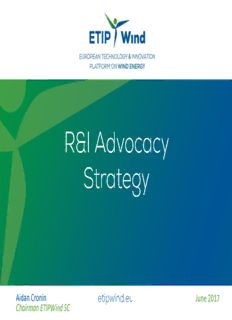
R&I Advocacy Strategy PDF
Preview R&I Advocacy Strategy
Aidan Cronin June 2017 Chairman ETIPWind SC Capacity Forecast Onshore wind will remain the dominant technology, despite fast growth in global offshore deployment GW 2,500 2,000 1,500 Offshore wind Onshore wind 1,000 500 0 2012 2016 2020 2025 2030 2035 2040 Source: Bloomberg New Energy Finance Capacity Forecast Global generation mix TWh 40,000 100% Other 90% Solar thermal 35,000 Small-scale PV 80% 30,000 Utility-scale PV 70% Offshore wind 25,000 60% Onshore wind Biomass 20,000 50% Geothermal 40% 15,000 Hydro 30% Nuclear 10,000 20% Oil 5,000 Gas 10% Coal 0 0% Renewables share 2012 2016 2020 2025 2030 2035 2040 Source: Bloomberg New Energy Finance. Political context • Energy Transition: towards a decarbonized energy system by 2050: • Wind is providing for 10,4% of EU electricity demand today. The goal is to achieve 23,9% by 2030. • Global leadership in RES • EU wind turbine manufacturers held 39% share of the global market in 2015. • 92% of global installations offshore • Wind holds a majority share of the €35 bn. annual EU renewable energy exports. • Retain first-mover advantage in the global market WIND IS EUROPEAN, LOW RISK, EMISSIONS FREE & CARBON FREE Wind industry at a watershed • Growing competiveness with “conventionals” & other RES • Onshore is most competitive & could see another 26% cost reduction by 2025* • Offshore: prospect of subsidy-free deployments in the next decade* • Wind is a growing key strategic sector for the EU economy • 72 bn. Annual Turnover • 330.000 people employed • Strong EU presence across the value chain • +80% of components manufactured inside the EU * Dependent on appropriate policies , heavy R&I investment deployment of ample volumes Policy Caveats – EU still in Business as Usual mode • EU R&I is under pressure • 13% decrease in patent applications by leading EU companies between 2013 – 2015. • Growing competition in the global market • Need for a strong and stable home market (cfr. automotive & aviation) • Need for continuous innovation to bolster companies’ ability to export at competitive prices • Industrialisation & standardisation of production • Energy Management System • Ensuring the cleanest energy mix to society and the system Narrative Sharpening narrative for R&I advocacy Wind energy has achieved dramatic cost reduction thanks to major investments in R&I. EU funded projects have had a significant contribution to achieving this objective both in the in scale of and complexity of deployed technology. Leading to the biggest rotating machines on the planet. As wind is becoming a mainstream source of power generation, R&I needs to step- up its grid integration capabilities. EU funded projects are a major opportunity to build synergies with other sectors. Using captive wind for water treatment. The EU is the global leader on wind energy technology. However, to maintain technological leadership and economic competitiveness, continuous R&I support is needed. To support economic growth and the maturing of the industry, cutting-edge science/engineering and skilled scientists need to be delivered. The wind energy sector is confident that further cost reduction is achievable thanks to R&I. Delivering on zero-support offshore wind will require continuous R&I investments. Decreasing this effort puts a massive pipeline of projects at risk. Especially in light of the large investment in APAC. R & I Cost reduction priorities 1. Standardisation and creating an EU state-of-the-art technical protocol for components, fabrication & installation. Companies already working together but this has to be underpinned by research to boost this area further by supporting transnational initiatives and creating high quality lean and modular components. 2. Improved operation and maintenance planning and decision-making due to big data analytics plus common logistical coordination between different actors reduces cost considerably and onshore and offshore. Development of active repair robotics is in its infancy and extensive testing of this will be needed onshore for later offshore. 3. Demonstration of innovative on-& offshore wind technologies Wind is in a technological race as is aviation to develop and introduce new materials, better optimization and adaptive technologies as climate change comes. 4. Offshore wind farm research and innovation. Offshore wind is at such a scale that improvements in reliability and efficiency drive down the cost of wind dramatically. “The once a year visit dream”! Optimised floating technology is still 10 years away and much research and funding is needed to deliver the optimised solution. System management integration, grid interaction = The Digital Age R&I priorities 1. Energy Management Systems (EMS) with high RES penetration to optimise delivery to and storage of clean electricity to society. Digital is the key to delivery. 2. In depth technical and economic study for delivery of ancillary , black start and stand alone services throughout the entire value chain including technologies to be deployed and market value of these services; 3. Develop Modular offshore grid infrastructure enabling lower cost installation; 4. Development of next generation low loss and reliable electrical infrastructure within offshore wind farms. Including automised HV cable splicing 5. Integration of offshore meshed grids in the power markets to optimise technical solution and market value integration of offshore meshed grids in the power markets. Using captive wind for water treatment
Description: